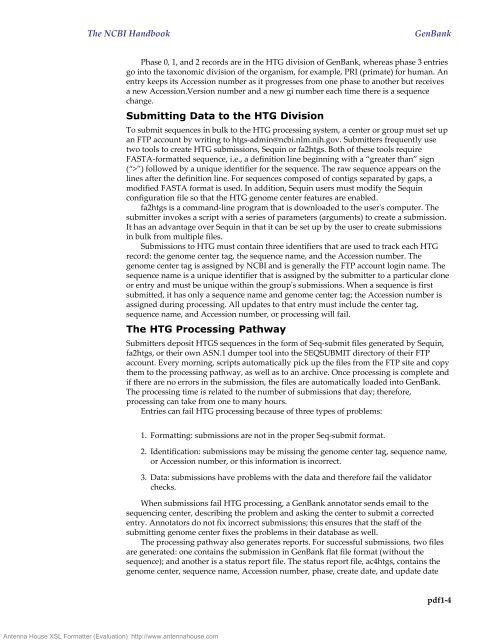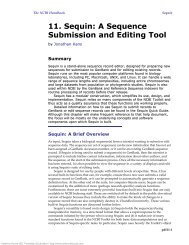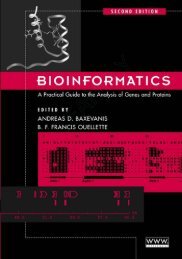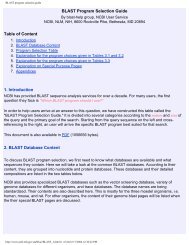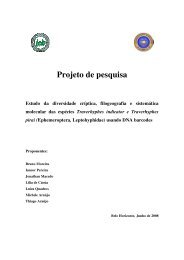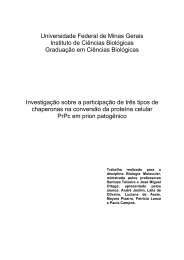1. GenBank: The Nucleotide Sequence Database
1. GenBank: The Nucleotide Sequence Database
1. GenBank: The Nucleotide Sequence Database
You also want an ePaper? Increase the reach of your titles
YUMPU automatically turns print PDFs into web optimized ePapers that Google loves.
Antenna House XSL Formatter (Evaluation) http://www.antennahouse.com<br />
<strong>The</strong> NCBI Handbook<br />
<strong>GenBank</strong><br />
Phase 0, 1, and 2 records are in the HTG division of <strong>GenBank</strong>, whereas phase 3 entries<br />
go into the taxonomic division of the organism, for example, PRI (primate) for human. An<br />
entry keeps its Accession number as it progresses from one phase to another but receives<br />
a new Accession.Version number and a new gi number each time there is a sequence<br />
change.<br />
Submitting Data to the HTG Division<br />
To submit sequences in bulk to the HTG processing system, a center or group must set up<br />
an FTP account by writing to htgs-admin@ncbi.nlm.nih.gov. Submitters frequently use<br />
two tools to create HTG submissions, Sequin or fa2htgs. Both of these tools require<br />
FASTA-formatted sequence, i.e., a definition line beginning with a “greater than” sign<br />
(“>”) followed by a unique identifier for the sequence. <strong>The</strong> raw sequence appears on the<br />
lines after the definition line. For sequences composed of contigs separated by gaps, a<br />
modified FASTA format is used. In addition, Sequin users must modify the Sequin<br />
configuration file so that the HTG genome center features are enabled.<br />
fa2htgs is a command-line program that is downloaded to the user's computer. <strong>The</strong><br />
submitter invokes a script with a series of parameters (arguments) to create a submission.<br />
It has an advantage over Sequin in that it can be set up by the user to create submissions<br />
in bulk from multiple files.<br />
Submissions to HTG must contain three identifiers that are used to track each HTG<br />
record: the genome center tag, the sequence name, and the Accession number. <strong>The</strong><br />
genome center tag is assigned by NCBI and is generally the FTP account login name. <strong>The</strong><br />
sequence name is a unique identifier that is assigned by the submitter to a particular clone<br />
or entry and must be unique within the group's submissions. When a sequence is first<br />
submitted, it has only a sequence name and genome center tag; the Accession number is<br />
assigned during processing. All updates to that entry must include the center tag,<br />
sequence name, and Accession number, or processing will fail.<br />
<strong>The</strong> HTG Processing Pathway<br />
Submitters deposit HTGS sequences in the form of Seq-submit files generated by Sequin,<br />
fa2htgs, or their own ASN.1 dumper tool into the SEQSUBMIT directory of their FTP<br />
account. Every morning, scripts automatically pick up the files from the FTP site and copy<br />
them to the processing pathway, as well as to an archive. Once processing is complete and<br />
if there are no errors in the submission, the files are automatically loaded into <strong>GenBank</strong>.<br />
<strong>The</strong> processing time is related to the number of submissions that day; therefore,<br />
processing can take from one to many hours.<br />
Entries can fail HTG processing because of three types of problems:<br />
<strong>1.</strong> Formatting: submissions are not in the proper Seq-submit format.<br />
2. Identification: submissions may be missing the genome center tag, sequence name,<br />
or Accession number, or this information is incorrect.<br />
3. Data: submissions have problems with the data and therefore fail the validator<br />
checks.<br />
When submissions fail HTG processing, a <strong>GenBank</strong> annotator sends email to the<br />
sequencing center, describing the problem and asking the center to submit a corrected<br />
entry. Annotators do not fix incorrect submissions; this ensures that the staff of the<br />
submitting genome center fixes the problems in their database as well.<br />
<strong>The</strong> processing pathway also generates reports. For successful submissions, two files<br />
are generated: one contains the submission in <strong>GenBank</strong> flat file format (without the<br />
sequence); and another is a status report file. <strong>The</strong> status report file, ac4htgs, contains the<br />
genome center, sequence name, Accession number, phase, create date, and update date<br />
pdf1-4


